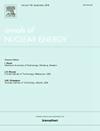SFR core-catcher safety issue: Experimentation and simulation of its ablation by an impinging jet
IF 1.9
3区 工程技术
Q1 NUCLEAR SCIENCE & TECHNOLOGY
引用次数: 0
Abstract
These coupled experimental and numerical studies support the safety demonstration of dedicated mitigation features in Sodium Fast Reactors (SFR). In order to limit potential power excursion in SFR core in the case of hypothetical severe accident, the implementation of the mitigation devices, called transfer tubes, was considered into actual French SFR core design. More specifically, they connect the core to the lower plenum and enable the early discharge of the corium towards the core-catcher. However, these devices, which effectively reduce the probability of reactivity excursions in the core, emphasize the issue of core-catcher thermomechanical resistance. Contrary to previous reactor core designs, the presence of these tubes could lead to coherent corium jets impinging the core-catcher surface. In the past, numerous studies dedicated to thermal ablation of a solid by a jet have been carried out to characterize the maximum ablated depth. Although these experiments are very valuable at a macroscopic scale, they do not give information about the local physical phenomena governing heat transfer and melting. Keeping this final goal in mind, this study followed a R&D methodology based on an experimental situation using simulant materials enabling direct visualization. In this paper, the ablation of an ice block by an immersed water jet and a free surface jet are investigated in conditions shown to be close to the reactor case. The physical analysis of the heat transfer at jet impingement and in its vicinity is characterized for the immersed jet conditions. Associated to the experimental part, CFD simulations of these tests are performed to validate the calculation methodology (mesh, turbulence models and interface melting…). In the future, simulations will be used in particular to characterize steel/ice transposition biases.
求助全文
约1分钟内获得全文
求助全文
来源期刊

Annals of Nuclear Energy
工程技术-核科学技术
CiteScore
4.30
自引率
21.10%
发文量
632
审稿时长
7.3 months
期刊介绍:
Annals of Nuclear Energy provides an international medium for the communication of original research, ideas and developments in all areas of the field of nuclear energy science and technology. Its scope embraces nuclear fuel reserves, fuel cycles and cost, materials, processing, system and component technology (fission only), design and optimization, direct conversion of nuclear energy sources, environmental control, reactor physics, heat transfer and fluid dynamics, structural analysis, fuel management, future developments, nuclear fuel and safety, nuclear aerosol, neutron physics, computer technology (both software and hardware), risk assessment, radioactive waste disposal and reactor thermal hydraulics. Papers submitted to Annals need to demonstrate a clear link to nuclear power generation/nuclear engineering. Papers which deal with pure nuclear physics, pure health physics, imaging, or attenuation and shielding properties of concretes and various geological materials are not within the scope of the journal. Also, papers that deal with policy or economics are not within the scope of the journal.
 求助内容:
求助内容: 应助结果提醒方式:
应助结果提醒方式:


